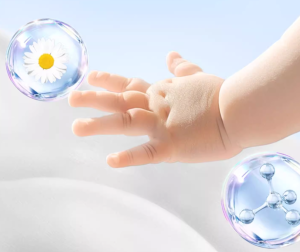1. Choose baby wet wipes for baby’s face
Newborn skin is 30% thinner than adult skin and sebaceous glands, sweat glands and other functional development are not mature. It is sensitive to bacterial infection and erosion by alkaline substances, and its resistance is weak. It is easy to be stimulated to produce skin allergies and even erosion. And in order to keep the baby fresh and clean, parents often give the baby a bath. The result is that the baby skin’s natural protective film will be washed away, the skin will become very dry. Baby environmentally friendly wet wipes are designed to clean the baby’s body. Winner Baby Wet Wipes meet stringent facial safety standards, dermatologists emphasize that water cleansing remains optimal for daily routines. When wipes are necessary (e.g., during travel or after feeding), our medical-engineered formula provides exceptional safety.
2. What do we need to notice when we use baby soft moisture wipes to wipe baby’s face
Patch Test First: Apply to baby’s inner wrist; wait 24hrs for reactions
Temperature Control: Use wipe warmers maintaining 37°C max to prevent solution evaporation
Moisturize After Use: Apply barrier cream immediately to counter drying effects
3. Why Parents Choose Winner Nonwovens Baby Wet Wipes?
Medical-Grade Pathogen Defense
Kills >99.99% of E. coli, S. aureus, and C. albicans
Pharmaceutical-grade disinfectants for food-contact areas (hands/mouth)
Ideal for pre-meal hand cleaning and post-feed face wiping
Clinically Validated SafetyPassed ISO 10993 biological evaluations:
Zero-irritation in acute oral toxicity tests
Negative oral mucosa/eye irritation results
Non-sensitizing in skin allergy trials
Skin-Intelligent Formulation
pH-balanced ≈6.7 (matches newborn skin)
Dual-soothing complex: Chamomile + Xylitol
3.5x saturation technology reduces wiping friction
Absolute Ingredient TransparencyGuaranteed 7-Free Formula:✗ Alcohol ✗ Fragrance ✗ MIT/CIT✗ Dyes ✗ Fluorescers ✗ Formaldehyde
Planet-Safe Design
90-day biodegradation rate >85% (third-party verified)
100% compostable materials












